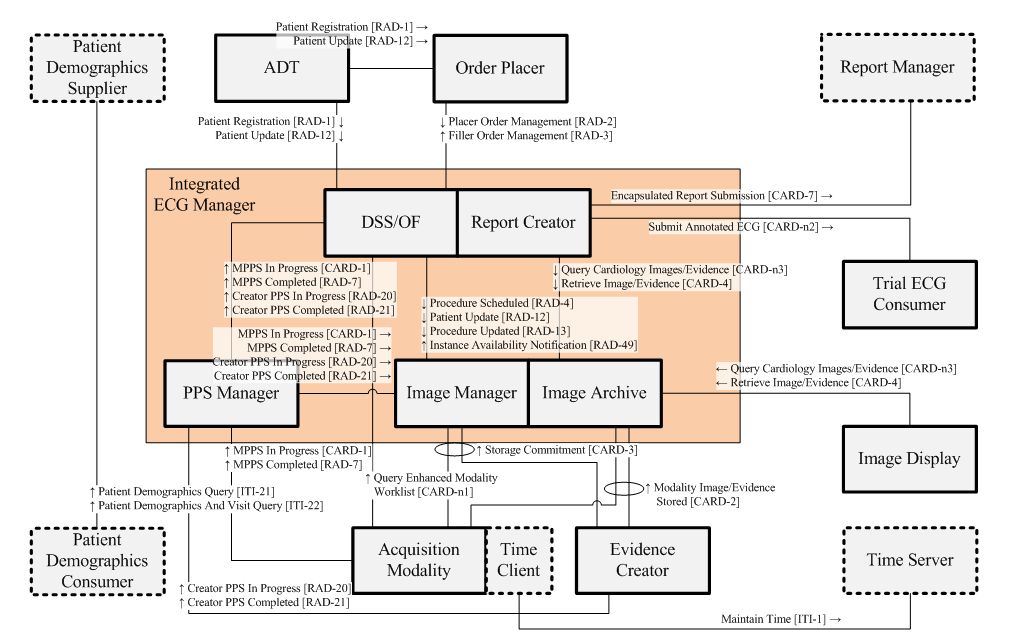Difference between revisions of "Resting ECG Workflow"
| Line 25: | Line 25: | ||
* Bridges the gap between HL7-based systems (like CVIS) and DICOM-based systems (like ecg carts and PACS) within the cardiology department by specifying the semantic mappings between messages. | * Bridges the gap between HL7-based systems (like CVIS) and DICOM-based systems (like ecg carts and PACS) within the cardiology department by specifying the semantic mappings between messages. | ||
* Maintains the consistency of patient demographic and ordering information across multiple systems by making that information available to ecg carts via the DICOM Modality Worklist (MWL) Service. | * Maintains the consistency of patient demographic and ordering information across multiple systems by making that information available to ecg carts via the DICOM Modality Worklist (MWL) Service. | ||
| − | * Allows storage and management of ECG evidence documents | + | * Allows storage and management of ECG evidence documents and final report creation and storage |
* Ensures that acquired ecgs are not inadvertently lost by specifying that the DICOM Storage Commitment Service is used to transfer the custodianship of images from the modality to the PACS. | * Ensures that acquired ecgs are not inadvertently lost by specifying that the DICOM Storage Commitment Service is used to transfer the custodianship of images from the modality to the PACS. | ||
* Ensures that the status of acquisition workflow steps are known throughout the department by specifying the use of the DICOM Modality Performed Procedure Step (MPPS) Service to convey that status from the modality to the CVIS and the PACS. | * Ensures that the status of acquisition workflow steps are known throughout the department by specifying the use of the DICOM Modality Performed Procedure Step (MPPS) Service to convey that status from the modality to the CVIS and the PACS. | ||
Revision as of 08:42, 1 August 2011
Summary
Resting Electrogcardiograms (ECGs) are a widely perscribed diagnostic test in Cardiology. Current workflows are based on proprietary communication protocols, which hamper interoperability and clincal workflows.
The profile describes workflows associated with digital electrocardiography. Similar to the Cath and Echo Workflow integration profiles, this profile deals with patient identifiers, orders, scheduling, status reporting, and data storage. It also addresses the issues of acquisition modality devices that are intermittently connected to the network, such as portable electrocardiograph machines, as well as ECG-specific data requirements. The Resting ECG Profile will handle the cases of unordered and urgent ECG tests and ECGs acquired in both hospital and office settings. It also handles ECGs acquired for the purposes of clinical trials and research.
Benefits
- Allows multi-vendor interoperability between major subsystems:
- Registration and ordering (HIS, CVIS)
- ECG archive (PACS, ECG Management)
- Acquisition devices (Electrocardiographs)
- ECG analysis and reporting workstations (ECG or PACS Workstations)
- ECG report consumers (EMR)
- Uses HL7 transactions for HIS and EMR
- Uses DICOM transactions for acquisition devices and workstations
- ECG waveforms stored as DICOM General ECG Waveform objects
- ECG measurements and interpretations stored as DICOM Structured Reports
- An “Integrated ECG Manager” actor makes it easier for traditional ECG management products to adopt this profile
Details
The Resting ECG Workflow (REWF) Integration Profile:
- Establishes the continuity and integrity of basic departmental ecg data by profiling specific usage of HL7 messaging across multiple systems including: Patient registration (ADT), Order Placing (CPOE) and Order Scheduling (CVIS) systems.
- Bridges the gap between HL7-based systems (like CVIS) and DICOM-based systems (like ecg carts and PACS) within the cardiology department by specifying the semantic mappings between messages.
- Maintains the consistency of patient demographic and ordering information across multiple systems by making that information available to ecg carts via the DICOM Modality Worklist (MWL) Service.
- Allows storage and management of ECG evidence documents and final report creation and storage
- Ensures that acquired ecgs are not inadvertently lost by specifying that the DICOM Storage Commitment Service is used to transfer the custodianship of images from the modality to the PACS.
- Ensures that the status of acquisition workflow steps are known throughout the department by specifying the use of the DICOM Modality Performed Procedure Step (MPPS) Service to convey that status from the modality to the CVIS and the PACS.
Systems Affected
Systems involved in this profile are:
- Enterprise-wide information systems that manage patient registration and services ordering (i.e., admit-discharge-transfer (ADT)/registration system and hospital information system)
- Cardiology information systems that manage department scheduling and report creation
- Picture Archiving and Communication Systems that manage storage of images, waveforms and evidence documents.
- Review workstation that allow for querying, retrieving and displaying images, waveforms (ecg) and evidence documents
- ECG carts for the acquisition of waveform data and evidence documents.
Actors & Transactions:
Specification
Profile Status: Trial Implementation
Documents:
- IHE Cardiology Technical Framework:
- Vol. 2 - Sections 4.1 and 4.3
- IHE Cardiology Technical Framework:
- IHE Radiology Technical Framework:
- Vol. 2 - Sections 4.1 to 4.3, 4.12, 4.20 to 4.21
- IHE Radiology Technical Framework:
- Displayable Reports Supplement - Section 4.7
Underlying Standards:
See Also
Related Profiles
- Displayable Reports [DRPT] for storage and managements of reports.
- Consistent Time [CT] to allow exact timestamps during ecg acquisition
- Patient Demographics Query [PDQ] to obtain patient demographics for unscheduled patients
Consumer Information
Implementer Information
Reference Articles
This page is based on the Profile Overview Template
